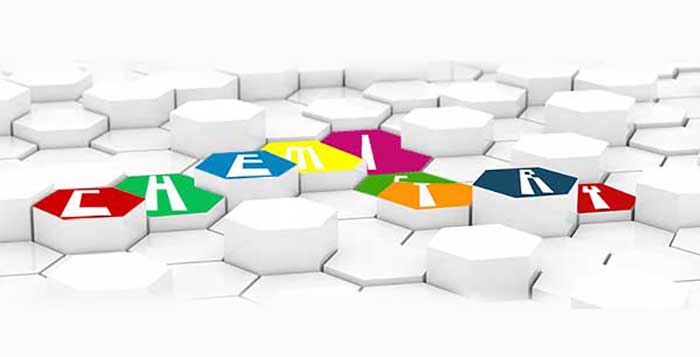Do you know how which effect Chemistry has on FIFA 14 Ultimate Team matches ? Do you know what you should do to get the higher Chemistry possible ? Do you know how it is calculated ?
The answers to these and many other questions are in this vast guide that was made for beginners and experienced players.
We went in a deep search and found everything there is to be discussed about this theme. Cause chemistry is extremely important in FUT 14, be sure to read this guide.
Quick Access
- What is Chemistry ?
Basic Concepts
What Influences and How to Improve the Chemistry
How the Chemistry is Calculated
Which Chemistry can be Reached
Chemistry Styles
The Substitutes’ Chemistry
What has Changed
Common Mistakes
Basic Tips
Advanced Techniques
Chemistry Seen by the Outside
Frequently Asked Questions (FAQ)
What is Chemistry in FIFA 14 Ultimate Team ?
Our skills as gamers is not the only thing important to win a match. The efficiency of our players on the pitch and of the team in general depends directly on three main factors:
- The player’s attributes;
- The Chemistry;
- The Player’s Fitness;
The Chemistry takes a fundamental role on your team’s performance, so it can never be despised. It represents how well a player will perform in-game. Low chemistry values will hinder players’ ability, whilst high chemistry values will result in players performing well.
It evaluates the health of every relation in a club. In other words, the chemistry is a factor that helps the game play by interacting with the familiarity of the player with the club and his positioning, the relation with the other players and the manager.
In the end, that is what the chemistry does. Take all these situations, weigh how much they can benefit the performance of a team and transfer them to the four lines of this evaluation.
In general, the introduction for chemistry in FIFA 14 Ultimate Team is there to give more logic to the game and to make the building of a team more complex, challenging and diverse.
Basic Concepts of Chemistry in FIFA 14 Ultimate Team
The first idea that has to be present is that the chemistry is extremely important for the success of any team. In previous editions, EA have announced that “a bronze team with chemistry 100 can win without great difficulties a gold team without chemistry”. That is why it has to be taken seriously when you plan to start a new team. The team should be built around chemistry and not the opposite.
Another important concept, which is not always present, is that there are two kinds of chemistry: each player’s individual chemistry and the chemistry of the team.
Both influence the performance of the players on the pitch. Individual chemistry varies between 0 and 10 and team chemistry between 0 and 100. The chemistry values can be viewed on the active squad menu, just like the image below demonstrates.
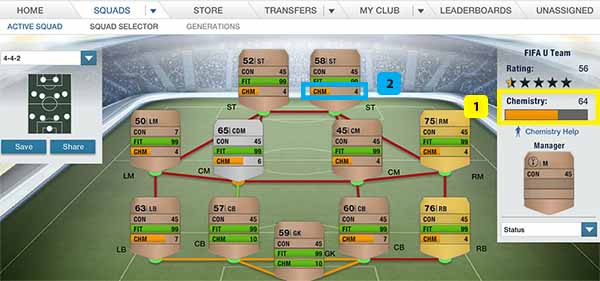
Active Squad Menu: 1- Team Chemistry; 2- Individual Chemistry
To see the individual chemistry you need to select ‘Status’ under the manager
Click over the picture to maximize it
Any player should have as a goal building a team with the highest chemistry possible. The higher is the value, the better. The priority should be given to an individual chemistry close to or equal 10. It is also a good thing to get a team chemistry of 100.
The chemistry of the team depends exclusively of the gamer choices. It’s higher or lower depending on the players he chooses for the starting eleven, the manager he picks for the bench and the positioning of each one of the players. That way, it varies from match to match.
Now that you already know what the chemistry is, it’s time to know what it does in practice.
The chemistry interferes directly on the potential efficiency of the team during the match. More precisely, on the players’ attributes. That way, in the beginning of each match, the players’ attributes are directly affected by their individual chemistry and also by the team’s depending on the chemistry style that is active.
What influences the Chemistry and How to Improve it
The Chemistry measures several factors that are considered enough important to affect the performance of a player.
Here is what influences a player Chemistry in FIFA 14 Ultimate Team:
- His position
- His relation with team mates
- His relation with the manager
- His loyalty to the club
If he is playing in his natural position
If the players next to him have the same nationality or play in the same league or club as him
If his manager is from the same league or nationality
If he played more than 10 matches or if it is his first club
Player Position
Normally, the players are habituated to play on a determined position but they can adapt themselves to similar positions. That is also what happens in FUT 14.
According to his positioning, a player may be in one of the following situations:
- Playing in his natural position
- Playing in a position that is very similar to his natural position
- Playing in a position that has some similarities to the natural position
- Playing in a position that is very different from the natural position
The natural position of a player is shown on his card. The position where he’s about to play is shown on the active squad menu. The first situation refers to when both positions are the same. That is the greatest situation to benefits the chemistry.
When a player is assigned to play in a strange position for himself, the chemistry is strongly affected. The goalkeepers is a good example of that. They can only play well on the goal, and are the only players that can’t get adapted to another position.
In order to know what positions a player can get adapted to, consult the table from the FIFA 14 Ultimate Team calculation chapter.
When a player’s preferred position doesn’t match with the position he’s about to play, it’s possible to fix this applying a position modifier card. These cards can only be applied with success if they indicate the current preferred position of the player and the one he will play. You can learn more about it HERE.
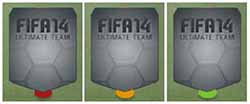
The position a player is in is represented by Player Position Icons, found directly underneath the Player Card: green means that he is playing on his natural position, orange means that he is playing in an adapted position and red means that he is playing on a position that is very different from the natural position.
Relation with the other Players
The more two players have in common, the higher will be the chemistry and better they will play.
Chemistry links are connections between players in a team. When two players are placed next to each other, they form a connection. This connection is represented by a coloured link, according to the intensity of the relation, and can be classified in:
- Dead Link
If the connection is between two players with different nationalities, different clubs and different leagues (Ronaldo and Hulk, for example); - Weak
If the connection is between two players with the same nationality and different leagues OR if they are from the same league but different clubs (Aguero and Garay, for example); - Strong
If the connection is between two players with the same nationality and league but different clubs OR if it’s between two players from the same club (Pique and Sergio Ramos, for example); - Hyper
If the connection is between two players with the same nationality and club (Mata and Torres, for example).

Coloured links: green for hyper and strong, orange for weak and red for dead link.
The dead links are the weakest connections and consequently the most penalising for the chemistry.The hyper ones are the strongest and the most rewarding connections for the chemistry.
Independently of the team formation, a player must be linked to 2, 3, 4, 5, 6 or 7 team mates. The stronger these connections are, the higher will be the player’s individual chemistry.
That’s why most FUT 14 teams are built based in a league or in a nationality. This way it’s possible to eliminate the dead links and guarantee a high chemistry.
The relations between players can also possible to improved, but in order to do that, it’s necessary to adjust the team. Before buying players for the team, gamers should verify the connections intensity they will get. If they are sufficiently weak at a point that they can affect the chemistry, they should find players that can be well combined according to their nationality, league or club.
The intensity of the connection between two players is merely a graphic representation. It doesn’t mean that these players, in particular, play well with each other if their connection is green. What really counts for the individual chemistry is the summation of the intensities of the connections that a specific player has. Each player’s attributes are affected and not necessarily his relation with the team mates. So, any player plays the same way among all his team mates independently that he has different coloured connections.
Relation with the Manager
To boost contracts is not the only manager’s role. To each player, he may give an extra chemistry point. In FUT 14, the manager doesn’t influence the team’s chemistry directly. He do it to the individual chemistry.
There are two manager’s characteristics that will vary the chemistry of a player:
- His nationality
- His league
A manager that can be well comprehended has more success probabilities than one with worse relationships with the players. That’s why the chemistry is improved if the manager’s nationality or/and the manager’s league is the same as most players’.
The nationalities and the leagues of the players and managers are shown on the front of their cards.
To get the manager bonus, players should try to match the manager nationality or the manager league with the higher number of players from the start eleven. Pay attention that it may not be always true. For example: if all the players except one are from one specific league and already have individual chemistry 10, it may be better to try to match the manager league with the league of the only player that doesn’t have the higher chemistry possible.
When a manager league’s doesn’t match with the player’s league, it’s possible to fix this applying a league modifier card. You can learn more about it HERE.
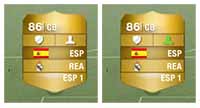
Manager bonuses are represented by icons on the player card. A green icon means the player is receiving a bonus because he has, at least, the same nationality or the same league of the manager.
Loyalty with the Club
Loyalty is a brand new feature designed to further reward UT players for opening packs or keeping a player for an extended amount of games. After 10 matches of playing with the same player, or using a player pulled from a pack, the player will receive a bonus to his Individual Chemistry. He only needs one of these two things to get the bonus.
It is very easy to get this bonus. Even if it is unusual to buy packs, the player just need to play 10 matches with that card to get the bonus.
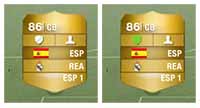
Loyalty bonuses are represented by icons on the player card. A green icon means the player is receiving a bonus because he played ten or more matches in this club or because it is his first club (or both).
How the Chemistry is calculated in FIFA 14 Ultimate Team
The way the chemistry is calculated is probably the most well guarded secret in FIFA 14 Ultimate Team.
We came up with the idea of uncovering it.
The Chemistry Effect on the Game
In the first place it is important to know that the chemistry value that is used in game is the weighted average of the individual chemistry (75%) and the squad’s chemistry (25%).
Unlike many people think, having individual chemistry values of 10 is much more important than having a value of 100 on the squad’s chemistry display.
Even because the individual chemistry doesn’t only weights three quarters of the chemistry utilized on the game, but it also affects directly the chemistry of the squad, as we’re going to see next.
In other words, you can say that the attributes that each player starts a match with depend directly on the individual chemistry and partially on the squad’s chemistry. The following equation shows how the chemistry in game is calculated for each player:
For example: a player with individual chemistry 10 on a squad with team chemistry 90 will play better than a player with individual chemistry 9 on a squad with team chemistry 100 (9.75 > 9.25).
Team’s Chemistry Calculation
Team Chemistry represents an accumulation of all the Individual Chemistry values. It varies between 0 and 100 and can be calculated with the following formula:
where
TC is the team’s chemistry
IC is the player’s individual chemistry (to be seen further)
This formula allows team’s chemistries up to 110. However, in practical terms, any value that is superior to 100 has the same effect as 100.
Individual Chemistry Calculation
The Individual Chemistry varies between 0 and 10 and can be calculated with the following formula:
where
IC is the individual chemistry of a player
PLC is the positioning and links chemistry
MB is the manager bonus
LB is the loyalty bonus
This formula allows individual chemistries up to 12. However, in practical terms, any value that is superior to 10 has the same effect as 10. Being possible, in theory, to get more than chemistry 10, allows other ways to reach the maximum chemistry and increases the diversity of teams with high chemistry.
Position and Links Chemistry (PLC)
The PLC depends of the player’s position and of the connections with his team mates. It varies between 0 and 10 and can be known on the following table:

Read the text below to understand how to get the PLC from this table
The columns correspond to the four categories of player’s positioning: red if he is in wrong position; orange if he is in an unrelated position; yellow if he is in a related position; green if he is in his natural position.
The following table shows all the combinations of possible positions:
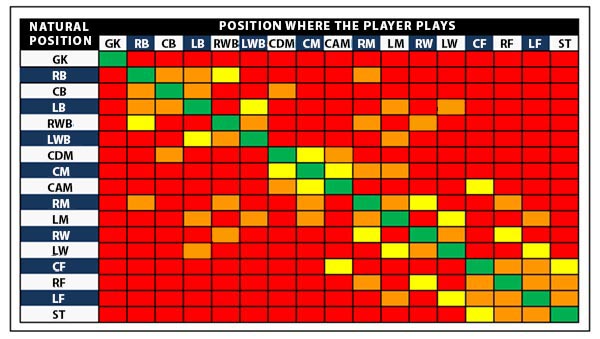
The rows correspond to the value L, which measures the links intensity of a player with his team mates, and that can be calculated as follows:
L = Sum of the numerical value of links received from surrounding players / Number of Links
The Numerical value of a link can be:
- 3 (Hyper Link – Green)
Same Nationality and Club
- 2 (Strong Link – Green)
Same Club but different Nationality
Same nationality and League but different Club
- 1 (Weak Link – Orange)
Same League but different Nationality and Club
Same Nationality but different League
- 0 (Dead Link – Red)
Different Club, League and Nationality.
Manager Bonus (MB)
The main Managers increase the Individual Chemistry by 1 point for every player that has a matching nation or a matching league.
However, the Individual Chemistry boost of players with the same league and nation is 1. The bonus can not be higher than 1, so matching an individual player’s league and nation is not important.
Loyalty Bonus (LB)
Loyalty increases the Individual Chemistry by 1 point for every player that has pulled from a pack (first owner) or has played 10 matches.
However, the Individual Chemistry boost of first owners cards with more than 10 matches is 1. The bonus can not be higher than 1, so getting these two thing is not important.
FIFA 14 Ultimate Team Chemistry Calculation Example
It is too easy to find the team’s chemistry but, in order leave no doubts, we’ll calculate a hypothetical individual chemistry.
Imagine that we are trying to place Neymar as LM on our 4-4-2 BBVA squad but we don’t have enough coins to buy his TOTW card. With the TOTW card is easy to get individual chemistry 10 but with the regular card how much he can reaches ?
The first thing to do is to see in the table of positions which ones have something to do with LM. Applying ST-CF, CF-CAM and CAM-CM cards, he will become a CM, an unrelated position to LM (orange). He has two strong links (same league and nationality with Marcelo, and same club with Xavi) and one weak link (same league with Benzema), in three links possible. It means that L = (2+2+1)/3 > 1.6. So, looking this L on the orange column of the PLC table, we find that Neymar chemistry is 5, without bonuses. He didn’t need so much good connections since he would get the same chemistry even if L was lower than 1.6 and higher or equal than 1. With a manager from BBVA and playing more than 10 matches, he gets two extra chemistry points (5 to 7).
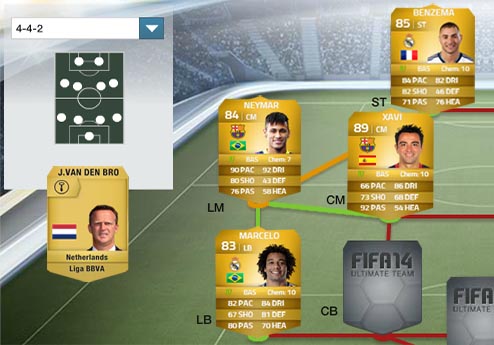
You can also use THIS calculator to find the squad and the individual chemistry.
Which Chemistry Can Be Reached
We have already explained how to calculate the chemistry, but for the lazy, we added this chapter where we show some interesting conclusions, directly and without any calculation.
One of the most common questions is about the maximum chemistry that a player might get when playing out of his natural position. The answer is given in the table below. These values not include the manager’s bonus and loyalty bonus, so can still be added two more points.
We can use the table to check our previous example with Neymar: playing as LM, the better that he can get is 7, after applying the two bonuses points.
| NATURAL POSITION | POSITION WHERE THE PLAYER PLAYS | ||||||||||||||||||
| GK | RB | CB | LB | RWB | LWB | CDM | CM | CAM | RM | LM | RW | LW | CF | RF | LF | ST | |||
| GK | 10 | 2 | 2 | 2 | 2 | 2 | 2 | 2 | 2 | 2 | 2 | 2 | 2 | 2 | 2 | 2 | 2 | ||
| RB | 2 | 10 | 5 | 5 | 9 | 2 | 2 | 2 | 2 | 5 | 2 | 2 | 2 | 2 | 2 | 2 | 2 | ||
| CB | 2 | 5 | 10 | 5 | 2 | 2 | 5 | 2 | 2 | 2 | 2 | 2 | 2 | 2 | 2 | 2 | 2 | ||
| LB | 2 | 5 | 5 | 10 | 2 | 9 | 2 | 2 | 2 | 2 | 5 | 2 | 2 | 2 | 2 | 2 | 2 | ||
| RWB | 2 | 9 | 2 | 2 | 10 | 5 | 2 | 2 | 2 | 5 | 2 | 5 | 2 | 2 | 2 | 2 | 2 | ||
| LWB | 2 | 2 | 2 | 9 | 5 | 10 | 2 | 2 | 2 | 2 | 5 | 2 | 5 | 2 | 2 | 2 | 2 | ||
| CDM | 2 | 2 | 5 | 2 | 2 | 2 | 10 | 9 | 5 | 2 | 2 | 2 | 2 | 2 | 2 | 2 | 2 | ||
| CM | 2 | 2 | 2 | 2 | 2 | 2 | 9 | 10 | 9 | 5 | 5 | 2 | 2 | 2 | 2 | 2 | 2 | ||
| CAM | 2 | 2 | 2 | 2 | 2 | 2 | 5 | 9 | 10 | 2 | 2 | 2 | 2 | 9 | 2 | 2 | 2 | ||
| RM | 2 | 5 | 2 | 2 | 5 | 2 | 2 | 5 | 2 | 10 | 5 | 9 | 2 | 2 | 5 | 2 | 2 | ||
| LM | 2 | 2 | 2 | 5 | 2 | 5 | 2 | 5 | 2 | 5 | 10 | 2 | 9 | 2 | 2 | 5 | 2 | ||
| RW | 2 | 2 | 2 | 2 | 5 | 2 | 2 | 2 | 2 | 9 | 2 | 10 | 5 | 2 | 9 | 2 | 2 | ||
| LW | 2 | 2 | 2 | 2 | 2 | 5 | 2 | 2 | 2 | 2 | 9 | 5 | 10 | 2 | 2 | 9 | 2 | ||
| CF | 2 | 2 | 2 | 2 | 2 | 2 | 2 | 2 | 9 | 2 | 2 | 2 | 2 | 10 | 5 | 5 | 9 | ||
| RF | 2 | 2 | 2 | 2 | 2 | 2 | 2 | 2 | 2 | 5 | 2 | 9 | 2 | 5 | 10 | 5 | 5 | ||
| LF | 2 | 2 | 2 | 2 | 2 | 2 | 2 | 2 | 2 | 2 | 5 | 2 | 9 | 5 | 5 | 10 | 5 | ||
| ST | 2 | 2 | 2 | 2 | 2 | 2 | 2 | 2 | 2 | 2 | 2 | 2 | 2 | 9 | 5 | 5 | 10 | ||
Another question that players usually ask to us is how to get the maximum chemistry possible. Here are the minimum requirements:
- Players in the right position and with the manager’s bonus or loyalty bonus
The sum of the numerical value of links should be equal or higher than the number of links
- Players in the right position without bonus
The sum of the numerical value of links should be 1.6 times higher than the number of links
- Players in a related position and with the manager’s bonus or loyalty bonus
The sum of the numerical value of links should be 1.6 times higher than the number of links
- Players in a related position and with both manager’s bonus and loyalty bonus
The sum of the numerical value of links should be equal or higher than the number of links
Chemistry Styles in FIFA 14 Ultimate Team
Chemistry Styles is a brand new thing on FUT 14. It may be a bit complex on the start but we are here to show you that it is more simpler than most of gamers think.
Chemistry Styles Introduction
Chemistry Styles are consumable cards. As any other consumable, they can be purchased on the market, or obtained from a pack.
In FUT 13, players receive boosts for every stat. In FUT 14, players receive boosts for a chosen number of stats dependent on the Chemistry Style selected. These cards can be applied to a player to change their style of play adjusting the players attributes to their squad needs.
The chemistry styles cards do not change the chemistry numbers. These cards allow players to choose which stats will be affected by chemistry. They redistribute the stats that will receive chemistry boosts. Chemistry boosts will increase the value of specific in-game stats – thus increasing the player’s ability to perform.
Each one of these cards can only be used once. However, they can be applied to each player as many times the gamer want but only one per player at a time. As it happens with positioning cards, its effects are permanent until a new chemistry style is applied to the player. When someone trade a player card, the buyer will keep the style that it is active.
There are 24 chemistry styles: 19 for outfield players and 5 for goalkeepers. You can check the effect of each one of these cards in the table on the end of this chapter (look to ‘chemistry 10’ section). An outfield player chemistry style can be applied to any outfield player. However, goalkeepers chemistry styles are exclusive to goalkeepers and outfield player chemistry styles cannot be applied to a goalkeeper. Chemistry style cards can also be applied to In Form cards, including Legends.
You can read more about chemistry styles cards HERE.
The Arrows’ Meaning
There are two things that we can find on a player’s card about the chemistry styles. The first one is the name of the style that is active in that player. The second one are small arrows showing which stats will be affected by the chemistry and the maximum available stat boost.
These arrows can be white or green. A white arrow indicates a possible boost that isn’t being received, which will mean that player doesn’t currently have high enough Chemistry to get the maximum benefit. A green arrow indicates that the stat will be boosted. The more arrows per stat, the bigger will be the available boost. The more green arrows per stat, the bigger will be the boost.
There are 24 Chemistry Styles and they all have a maximum of six arrows that can be allocated to different attributes. When a player is released in a card his chemistry style is basic (BAS), the starter style. It means that all his six attributes may be improved in the same way by one arrow. A single green arrow gives a small boost to the associated attribute, two green arrows give a medium boost and three give the maximum boost possible. For the Chemistry Styles that affect three attributes, the maximum boost to each is two green arrows. For the Chemistry Styles that affect two attributes, the maximum boost to each is three green arrows.
The goal of any player should be to fill all available arrows. In order to do that, is requested an high chemistry as we will see later. The maximum number of arrows that can be filled is 6 for each player card.

In the first picture, the player has six white arrows, one for each stat. It means that all the stats will be improved in the same way, but right now he doesn’t have enough chemistry. In the second picture, the player has full chemistry, which means that he will get the boost for all the stats. In the third picture, the chemistry style applied may give a medium boost to three stats and in the fourth the chemistry style applied may give a maximum boost to two stats.
How to Get Green Arrows
As we have shown, to get green arrows we need high chemistry. But how much ? To know the relationship between Chemistry and arrows, just check the following table:
| CHEMISTRY | 10 | 9 | 8 | 7 | 6 | 5 | 4 | 3 | 2 | 1 | 0 | |
| GREEN ARROWS | 6 | 5 | 4 | 3 | 2 | 1 | 0 | 0 | 0 | 0 | 0 |
As we already have explained, with higher chemistry the boosts will consequently be higher. Looking to this table you can see, for example, that if you place a player with a chemistry of 7, he will loose half of the boost. In the same way, if he only has 4 of chemistry, it makes no sense to apply him a chemistry style since no stat will be boosted. To chemistry values lower than 4 the in-game stats of the particular player will gradually be lowered, hindering the player’s ability.
You probably have understood that for chemistries lower than 10, there will be less stats boosted. But which stats are affected by lower chemistries ? In a basic chemistry style, for example, if the player has chemistry of 9, which stat loose its boost ? The answer is given in the following table:
| CHEMISTRY 10 | |||||||||
| DIV | HAN | KIC | REF | SPD | POS | ||||
| BASIC GK | BAS | GK | MIN | +1 | +1 | +1 | +1 | +1 | +1 |
| CAT | CAT | GK | MED | +2 | +2 | +2 | |||
| GLOVE | GLO | GK | MED | +2 | +2 | +2 | |||
| SHIELD | SLD | GK | MED | +2 | +2 | +2 | |||
| WALL | WAL | GK | MED | +2 | +2 | +2 | |||
| PAC | SHO | PAS | DRI | DEF | HEA | ||||
| BASIC PLAYER | BAS | MIN | +1 | +1 | +1 | +1 | +1 | +1 | |
| SENTINEL | SEN | DEF | MAX | +3 | +3 | ||||
| GUARDIAN | GRD | DEF | MAX | +3 | +3 | ||||
| GLADIATOR | GLA | DEF | MAX | +3 | +3 | ||||
| BACKBONE | BAC | DEF | MED | +2 | +2 | +2 | |||
| ANCHOR | ANC | DEF | MED | +2 | +2 | +2 | |||
| ARTIST | ART | MID | MAX | +3 | +3 | ||||
| ARCHITECT | ARC | MID | MAX | +3 | +3 | ||||
| POWERHOUSE | PWR | MID | MAX | +3 | +3 | ||||
| MAESTRO | MAE | MID | MED | +2 | +2 | +2 | |||
| ENGINE | ENG | MID | MED | +2 | +2 | +2 | |||
| SNIPER | SNI | ATT | MAX | +3 | +3 | ||||
| DEADEYE | DEA | ATT | MAX | +3 | +3 | ||||
| HAWK | HWK | ATT | MED | +2 | +2 | +2 | |||
| MARKSMAN | MRK | ATT | MED | +2 | +2 | +2 | |||
| FINISHER | FIN | ATT | MAX | +3 | +3 | ||||
| HUNTER | HUN | SPE | MAX | +3 | +3 | ||||
| CATALYST | CTA | SPE | MAX | +3 | +3 | ||||
| SHADOW | SHA | SPE | MAX | +3 | +3 | ||||
| CHEMISTRY 9 | |||||||||
| DIV | HAN | KIC | REF | SPD | POS | ||||
| BASIC GK | BAS | GK | MIN | +1 | +1 | +1 | +1 | +1 | |
| CAT | CAT | GK | MED | +1 | +2 | +2 | |||
| GLOVE | GLO | GK | MED | +1 | +2 | +2 | |||
| SHIELD | SLD | GK | MED | +1 | +2 | +2 | |||
| WALL | WAL | GK | MED | +1 | +2 | +2 | |||
| PAC | SHO | PAS | DRI | DEF | HEA | ||||
| BASIC PLAYER | BAS | MIN | +1 | +1 | +1 | +1 | +1 | ||
| SENTINEL | SEN | DEF | MAX | +2 | +3 | ||||
| GUARDIAN | GRD | DEF | MAX | +2 | +3 | ||||
| GLADIATOR | GLA | DEF | MAX | +2 | +3 | ||||
| BACKBONE | BAC | DEF | MED | +1 | +2 | +2 | |||
| ANCHOR | ANC | DEF | MED | +1 | +2 | +2 | |||
| ARTIST | ART | MID | MAX | +2 | +3 | ||||
| ARCHITECT | ARC | MID | MAX | +2 | +3 | ||||
| POWERHOUSE | PWR | MID | MAX | +2 | +3 | ||||
| MAESTRO | MAE | MID | MED | +1 | +2 | +2 | |||
| ENGINE | ENG | MID | MED | +1 | +2 | +2 | |||
| SNIPER | SNI | ATT | MAX | +2 | +3 | ||||
| DEADEYE | DEA | ATT | MAX | +2 | +3 | ||||
| HAWK | HWK | ATT | MED | +1 | +2 | +2 | |||
| MARKSMAN | MRK | ATT | MED | +1 | +2 | +2 | |||
| FINISHER | FIN | ATT | MAX | +2 | +3 | ||||
| HUNTER | HUN | SPE | MAX | +2 | +3 | ||||
| CATALYST | CTA | SPE | MAX | +2 | +3 | ||||
| SHADOW | SHA | SPE | MAX | +2 | +3 | ||||
| CHEMISTRY 8 | |||||||||
| DIV | HAN | KIC | REF | SPD | POS | ||||
| BASIC GK | BAS | GK | MIN | +1 | +1 | +1 | +1 | ||
| CAT | CAT | GK | MED | +1 | +2 | +1 | |||
| GLOVE | GLO | GK | MED | +1 | +2 | +1 | |||
| SHIELD | SLD | GK | MED | +1 | +2 | +1 | |||
| WALL | WAL | GK | MED | +1 | +2 | +1 | |||
| PAC | SHO | PAS | DRI | DEF | HEA | ||||
| BASIC PLAYER | BAS | MIN | +1 | +1 | +1 | +1 | |||
| SENTINEL | SEN | DEF | MAX | +2 | +2 | ||||
| GUARDIAN | GRD | DEF | MAX | +2 | +2 | ||||
| GLADIATOR | GLA | DEF | MAX | +2 | +2 | ||||
| BACKBONE | BAC | DEF | MED | +1 | +2 | +1 | |||
| ANCHOR | ANC | DEF | MED | +1 | +2 | +1 | |||
| ARTIST | ART | MID | MAX | +2 | +2 | ||||
| ARCHITECT | ARC | MID | MAX | +2 | +2 | ||||
| POWERHOUSE | PWR | MID | MAX | +2 | +2 | ||||
| MAESTRO | MAE | MID | MED | +1 | +2 | +1 | |||
| ENGINE | ENG | MID | MED | +1 | +2 | +1 | |||
| SNIPER | SNI | ATT | MAX | +2 | +2 | ||||
| DEADEYE | DEA | ATT | MAX | +2 | +2 | ||||
| HAWK | HWK | ATT | MED | +1 | +2 | +1 | |||
| MARKSMAN | MRK | ATT | MED | +1 | +2 | +1 | |||
| FINISHER | FIN | ATT | MAX | +2 | +2 | ||||
| HUNTER | HUN | SPE | MAX | +2 | +2 | ||||
| CATALYST | CTA | SPE | MAX | +2 | +2 | ||||
| SHADOW | SHA | SPE | MAX | +2 | +2 | ||||
| CHEMISTRY 7 | |||||||||
| DIV | HAN | KIC | REF | SPD | POS | ||||
| BASIC GK | BAS | GK | MIN | +1 | +1 | +1 | |||
| CAT | CAT | GK | MED | +1 | +1 | +1 | |||
| GLOVE | GLO | GK | MED | +1 | +1 | +1 | |||
| SHIELD | SLD | GK | MED | +1 | +1 | +1 | |||
| WALL | WAL | GK | MED | +1 | +1 | +1 | |||
| PAC | SHO | PAS | DRI | DEF | HEA | ||||
| BASIC PLAYER | BAS | MIN | +1 | +1 | +1 | ||||
| SENTINEL | SEN | DEF | MAX | +1 | +2 | ||||
| GUARDIAN | GRD | DEF | MAX | +1 | +2 | ||||
| GLADIATOR | GLA | DEF | MAX | +1 | +2 | ||||
| BACKBONE | BAC | DEF | MED | +1 | +1 | +1 | |||
| ANCHOR | ANC | DEF | MED | +1 | +1 | +1 | |||
| ARTIST | ART | MID | MAX | +1 | +2 | ||||
| ARCHITECT | ARC | MID | MAX | +1 | +2 | ||||
| POWERHOUSE | PWR | MID | MAX | +1 | +2 | ||||
| MAESTRO | MAE | MID | MED | +1 | +1 | +1 | |||
| ENGINE | ENG | MID | MED | +1 | +1 | +1 | |||
| SNIPER | SNI | ATT | MAX | +1 | +2 | ||||
| DEADEYE | DEA | ATT | MAX | +1 | +2 | ||||
| HAWK | HWK | ATT | MED | +1 | +1 | +1 | |||
| MARKSMAN | MRK | ATT | MED | +1 | +1 | +1 | |||
| FINISHER | FIN | ATT | MAX | +1 | +2 | ||||
| HUNTER | HUN | SPE | MAX | +1 | +2 | ||||
| CATALYST | CTA | SPE | MAX | +1 | +2 | ||||
| SHADOW | SHA | SPE | MAX | +1 | +2 | ||||
| CHEMISTRY 6 | |||||||||
| DIV | HAN | KIC | REF | SPD | POS | ||||
| BASIC GK | BAS | GK | MIN | +1 | +1 | ||||
| CAT | CAT | GK | MED | +1 | +1 | ||||
| GLOVE | GLO | GK | MED | +1 | +1 | ||||
| SHIELD | SLD | GK | MED | +1 | +1 | ||||
| WALL | WAL | GK | MED | +1 | +1 | ||||
| PAC | SHO | PAS | DRI | DEF | HEA | ||||
| BASIC PLAYER | BAS | MIN | +1 | +1 | |||||
| SENTINEL | SEN | DEF | MAX | +1 | +1 | ||||
| GUARDIAN | GRD | DEF | MAX | +1 | +1 | ||||
| GLADIATOR | GLA | DEF | MAX | +1 | +1 | ||||
| BACKBONE | BAC | DEF | MED | +1 | +1 | ||||
| ANCHOR | ANC | DEF | MED | +1 | +1 | ||||
| ARTIST | ART | MID | MAX | +1 | +1 | ||||
| ARCHITECT | ARC | MID | MAX | +1 | +1 | ||||
| POWERHOUSE | PWR | MID | MAX | +1 | +1 | ||||
| MAESTRO | MAE | MID | MED | +1 | +1 | ||||
| ENGINE | ENG | MID | MED | +1 | +1 | ||||
| SNIPER | SNI | ATT | MAX | +1 | +1 | ||||
| DEADEYE | DEA | ATT | MAX | +1 | +1 | ||||
| HAWK | HWK | ATT | MED | +1 | +1 | ||||
| MARKSMAN | MRK | ATT | MED | +1 | +1 | ||||
| FINISHER | FIN | ATT | MAX | +1 | +1 | ||||
| HUNTER | HUN | SPE | MAX | +1 | +1 | ||||
| CATALYST | CTA | SPE | MAX | +1 | +1 | ||||
| SHADOW | SHA | SPE | MAX | +1 | +1 | ||||
| CHEMISTRY 5 | |||||||||
| DIV | HAN | KIC | REF | SPD | POS | ||||
| BASIC GK | BAS | GK | MIN | +1 | |||||
| CAT | CAT | GK | MED | +1 | |||||
| GLOVE | GLO | GK | MED | +1 | |||||
| SHIELD | SLD | GK | MED | +1 | |||||
| WALL | WAL | GK | MED | +1 | |||||
| PAC | SHO | PAS | DRI | DEF | HEA | ||||
| BASIC PLAYER | BAS | MIN | +1 | ||||||
| SENTINEL | SEN | DEF | MAX | +1 | |||||
| GUARDIAN | GRD | DEF | MAX | +1 | |||||
| GLADIATOR | GLA | DEF | MAX | +1 | |||||
| BACKBONE | BAC | DEF | MED | +1 | |||||
| ANCHOR | ANC | DEF | MED | +1 | |||||
| ARTIST | ART | MID | MAX | +1 | |||||
| ARCHITECT | ARC | MID | MAX | +1 | |||||
| POWERHOUSE | PWR | MID | MAX | +1 | |||||
| MAESTRO | MAE | MID | MED | +1 | |||||
| ENGINE | ENG | MID | MED | +1 | |||||
| SNIPER | SNI | ATT | MAX | +1 | |||||
| DEADEYE | DEA | ATT | MAX | +1 | |||||
| HAWK | HWK | ATT | MED | +1 | |||||
| MARKSMAN | MRK | ATT | MED | +1 | |||||
| FINISHER | FIN | ATT | MAX | +1 | |||||
| HUNTER | HUN | SPE | MAX | +1 | |||||
| CATALYST | CTA | SPE | MAX | +1 | |||||
| SHADOW | SHA | SPE | MAX | +1 |
Note that the numbers on the table are the number of arrows. It does not necessarily represent the number of in-game stat boost. There is no information about how many stat points are represented by one arrow.
The stats boost of this table can also give an idea of the in-game stats that are improved. For example, if the passing has been boosting, short pass and long pass will be also improved and in the same proportion.
Chemistry Styles Example
In order to show that chemistry style is something simpler than it seems, let’s see an example.
Imagine that in squad with chemistry 100, we have a player with full individual chemistry and maestro chemistry style activated. In-game, three of his stats will get a medium boost and the other three will remain the same as usual. Imagine now that we want to make some changes in our squad and in the new position he only gets chemistry 6. Instead of six green arrows, he only gets one green arrow for dribbling and other for passing (we can check this in the above table or selecting the player and scrolling left with the analogue stick). In these conditions, apply him an engine chemistry card has no effect at all, as you can see on the images below.

First image: player with chemistry 10 and maestro chemistry style
Second image: player with chemistry 6 and maestro chemistry style
Third image: player with chemistry 6 and engine chemistry style
Not having full chemistry is very penalized in the way how our players play. That’s why we strongly recommend to get individual chemistry 10 to all players. For those that it is not possible, try to get at least individual chemistry 8.
The Substitutes’ Chemistry in FIFA 14 Ultimate Team
If you were alert to the previous chapter you should have noticed that the substitutes are not considered in the chemistry calculation. And much less the reserves.
The team’s chemistry counts the summation of the starting eleven’s individual chemistries. Besides that, being on the bench, the substitutes don’t participate in the relations between the players. This means that the substitutes don’t have individual chemistry and that their contribution for the squad’s chemistry is merely null.
Until now we have judged that this is very easy to understand. Although, a very important question arises: if we make a substitution, what will be the chemistry of the player who goes in and how is it going to affect the team’s chemistry ?
The answer is simpler than what some people would think. When we make a substitution, the player who goes in acquires the chemistry of the player who goes out and this way the team’s chemistry remains the same. The decisive moment for the chemistry definition is the starting eleven set up. This means that, once the match has started, the chemistry values never change no matter what.
This is valid for all cases. Even if we put in a player that doesn’t have any relation with the others or if he’s put to play in a completely different position.
For some people this can be seen as an opportunity. It becomes possible to use that player we always wanted but could not use because he didn’t fit in our squad at all. We can also adapt players to other positions that usually don’t have quality choices.
Although, everything has a cost. In this case, contracts will be spent. Besides that we’ll have to interrupt the match, preferably in the beginning, to make these substitutions, which would be quite boring.
Note: The Substitutes’ Chemistry was not official confirmed, so we don’t have 100% sure if it is like this. Some sources says that the chemistry of a substitute is 1/11 of the Team’s Chemistry, which will be slightly different from what we explain above.
What has Changed in Chemistry
FIFA 14 brought to Ultimate Team several new things. Most of these news is about Chemistry. If you played UT in previous years, it may be interesting to know what has changes in Chemistry. Here is the list of the major changes:
- Team’s Chemistry
The way how team’s chemistry is calculated is different.
It is not required a manager to reaches team’s chemistry of 100.
- Individual Chemistry
The way how team’s chemistry is calculated is different.
The numerical value of a link has changed.
Two players with same nationality have now the same chemistry weight as two players with the same league.
The maximum individual chemistry possible is now 10, an not 9 as in previous years.
- Manager
Managers increase the Individual Chemistry. Team’s Chemistry is not directly increased by them as in the past.
It doesn’t matter to the chemistry if the manager is gold, silver or bronze.
The Formation of the manager no longer has weight in chemistry (it doesn’t exist any more).
The league of the manager is now important to individual chemistry.
- More Changes
Players with more games now receive loyalty bonus.
Cards on the hands of original owners are worth more in chemistry.
Several changes in the relation between natural positions and position where players play.
Same formations have now more connections.
Formations no longer have weight in chemistry.
The stats that are boosted by chemistry are now decided by the chemistry styles cards.
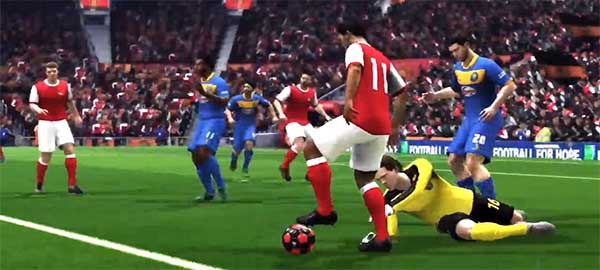
Common Chemistry Mistakes
There are three basic kinds of errors on the construction of a team with good chemistry in FIFA 14 Ultimate Team:
- The players underrate the importance of the chemistry
- The players overrate the chemistry
- The players don’’t give the chemistry its correct balance
- Squad’s Split Technique
- Key Players Technique
- Perfect Links Technique
In the first situation, some players seem not to know the effect of the chemistry on the game or simply judge that it’s nothing but a myth. They’d rather build a team with the players they like independently for the chemistry.
What they don’t know is that their development can be superior if they slightly modify the team substituting a few players. There’s no need to give up on all their preferences.
Unless they are just starting FUT 14, those players can be easily identified for showing up with a chemistry that is lower than 60 (it’s not possible to see the opponent’s individual chemistry).
There are also those who put the chemistry ahead of everything. Extremisms are not necessary. If you follow all of our basic tips (see on next chapter), you can be in this group. In fact, everyone who has all the starting eleven with an individual chemistry of 10 and the team’s chemistry of 100 can be in this situation.
FUT 14 allows players to reach maximum chemistry in a bunch of ways. If we apply all these methods to reach a chemistry above the maximum value, we are certainly overrating this concept. The problem about this is that we can prejudice the quality or diversity of our team without taking any advantage of it.
That’s why it’s important to know how the chemistry works in FIFA 14 Ultimate Team. With this knowledge we can build teams that have only what’s really necessary to reach maximum chemistry.
The teams that are made up of exclusively players from the same league, club or nationality are almost always typical cases of “chemistry waste”.
The third group is probably the most common one: the ones who commit errors when building a team because of the lack of knowledge about how to do it.
This happens because many times most sources of information are not clear enough or even incorrect about what they say of this theme.
It’s a common sense between FUT gamers that having a good chemistry is having a chemistry of 100. Wrong. We can have a team chemistry of 100 in which one player have an individual chemistry of zero. This is not really a desired chemistry.
The idea that circulates is that the chemistry of the team is the main thing and the individual chemistry, that many don’t know about, has little importance. This is severely false. The individual chemistry is actually the one that weighs more on the attributes set up during the matches.
These players usually have team chemistries of 100 but unbalanced individual chemistries. Some with 10 and others less than 8.
There are also some players that consider chemistry styles more important than the chemistry. That is false. One player without chemistry doesn’t need a chemistry style. Learn more about this in the chemistry styles chapter.
Chemistry Basic Tips
If you’ve read what we wrote in this article, then you already know what to do to build a team with good chemistry.
For those who still feel a little disorientated, we will give a few tips about how to build a team with good chemistry in FIFA 14 Ultimate Team.
In the first place, it’s convenient for us to define what is this “good chemistry” thing. For us, a team with a very good chemistry is one that has all individual chemistries of 10. It’s obvious that it’s not always possible to build our dream team full of individual chemistries of 10 but we should try to make them never lower than 8.
Unless you’re already an expert on this, the first step is to define what the players will have in common. We need them to have at least weak connections, since the most normal is for us to be based in a nationality or in a league to build our team.
A team that has all the players from the same league or from the same nationality, will have a very good chemistry, since the players are in their natural positions. According to our table, all of them will get, at least, individual chemistry of 9. It will be enough to have a manager of that league or nationality to get the higher chemistry possible.
We shouldn’t forget to save coins to invest on the chemistry. As it was already said, the players’ positioning may be corrected in most of the times if we have a budget for that. Having all players playing in their natural positions represents half way gone.
One of the tricks for being able to build this team is knowing how to plan it before we start. Just having a general idea is not quite enough because we can start buying players and realize at the end that we don’t have enough connections.
So, if we already chose what our players will have in common, it’s time to visualize what we intend to do for our team. To draw a scratch or to use a squad builder kind of application, seems to be a good move.
If you already built a team with good connections between players and with players in their natural positions, you already made the most difficult part. The easiest chemistry points are given by the active manager and by the loyalty. Ensure that the nationality and the league of the manager are well represented among the players with lower chemistry and, if you are not using players who you got in packs, try to reaches ten games as soon as possible to benefit from the two extra points.
If you did everything we said here then we guarantee you that the chemistry of your team will be the maximum possible.
Advanced Techniques to Build Squads with High Chemistry
You may have already understood how everything works but an extra help is always welcome at the point that we idealize our team.
We show you here three advanced techniques to build squads with good chemistry.
Overview: The hybrid squads are the most perfect we know. They allow us to go to other leagues and look for players to complete the positions we need. If built well, a hybrid team can join a good chemistry to a bigger variety of quality players. But building a hybrid team with good chemistry may not be easy. This technique consists, if the formation allows us, in cutting the team on half. Each side is filled with players from one league or one nationality. That is enough to get high chemistry, because there will be no player with more than one dead link.
Pros: It may also be applied, splitting the team transversely, ie between the defence and the midfield.
Very easy technique.
Cons: It is not possible to split teams into two parts for all the formations.
The players who connect with the other half may need a strong link to reaches the maximum chemistry.
Example: To show you how well this technique works, we have built a Ligue 1 / Bundesliga hybrid. The right side of the team is filled with players of the German league and the left side is filled with players of the French league. As you can see on the image below, only Moutinho and Lewandowski don’t have individual chemistry of 10. Every player that has a dead link, as it happens with them, needs a strong or a hyper link to reaches the maximum chemistry.
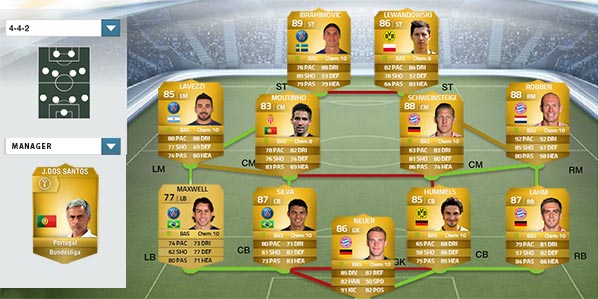
Click over the image to maximize it
Overview: There are some formations that are more favourable for building a hybrid team with high chemistry. It’s the case of the 4-2-3-1 formation, for having two key elements that allows split the team in two. These players should have characteristics that connect well with any of the two parts. In that way, it is possible to do something similar to the Squad’s Split Technique but the formation doesn’t need to be divisible and without the chemistry problems of the players that make the connection between the two leagues and/or two nationalities.
Pros: If the key players are well chosen, weak links will be enough in each one of the sides.
Cons: There are just a few formations suitable for this technique.
Example: To show you how well this technique works, we have built a hybrid squad with German and Spanish players. The key players in this 4-2-3-1 formation are the two CDM’s. To choose a German BBVA player and a Spanish Bundesliga player it is enough to get the maximum chemistry to all the German players in the attacking side and all the Spanish players in the defending side. It was not even necessary to place a manager.
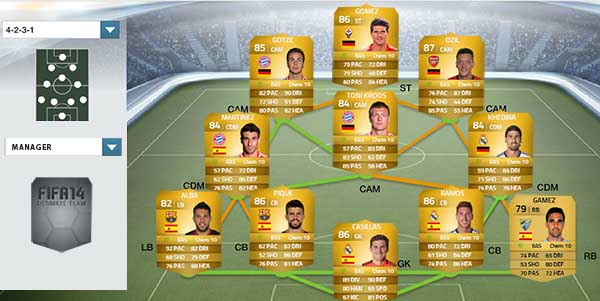
Click over the image to maximize it
Overview: The most experienced players can build a team that apparently presents just few things in common between the players. Unlike others, the perfect links technique is not based on a league or nationality but on hyper links. The same is to say that each player needs to be connected, at least, with a team mate from the same country and same club. For players with three or less connections, it is enough to get the maximum chemistry. The squads of this techniques are the most fantastic since it is possible to have more than 6 leagues and nationalities in the same single team.
Pros: This technique allows the building of truly unique teams.
Cons: The number of players with hyper links is limited.
For players with four or more connections, the maximum chemistry can only be reached with other links and bonuses.
Example: To show you how well this technique works, we have built a hybrid squad with players from four leagues. Although most of the connections are dead links (red), we got the maximum chemistry for almost every player. The exception is three players who have more than three links and on which the bonus manager should be focus. For players with only two connections, the hyper link may be replaceable by a strong link, without damaging the chemistry. This technique allows us to choose the players we feel more capable without thinking about their leagues and their nationalities.
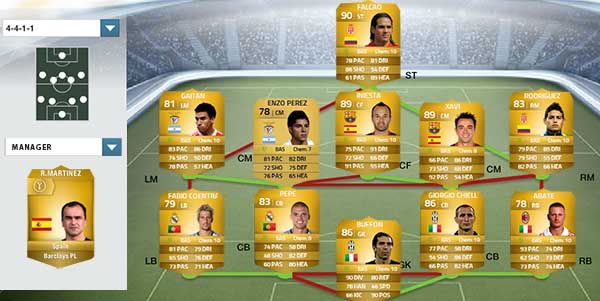
Click over the image to maximize it
The Chemistry Seen by the Outside
We are completely independent and this is great for us to be able to compliment or criticize what we think is good or bad.
In a general way we think that EA makes a very good job. It is true that there are server problems, items that get stuck on the trade pile, constant updates, etc… But when it comes to rules, FUT was a well made and implemented game. The chemistry system is a good example of that. It works and it has results.
But not everything makes sense on the chemistry of FIFA 14 Ultimate Team. We do not get why EA makes it so much secrecy. Most part of the information we published in this article was based on intensive tests we made. It is not available for the common player that doesn’t want to spend days trying to learn how the chemistry works.
The best example of what we are saying is the way how the links and the player’s positions are assigned according to the colours that indicate intensity. The hyper and strong connections are both green-coloured which doesn’t allow the distinction between each one. Also the player’s position status is indicated by only one colour, orange, which doesn’t allow the distinction between those that a player will be able to get adapted to. It would be enough just to introduce one more colour. We can only think that this was done intentionally so they could keep the chemistry secrets away from the players.
Another thing that makes no sense is not having any Brazilian manager. Since it is the nationality more used in FUT, why forcing many players to abdicate this point of chemistry ? No answer.
Our chemistry analyse does not end with EA. The players also make part of the game. There is a considerable number of people who insist that there is no such thing as the chemistry in the game. It is not true.
The best way for us to be certified about the influence of the chemistry on the game is playing several matches, ideally in the same condition, commanding a team with a high chemistry and another with a very low chemistry. We did this dozens of times and concluded that the chemistry in FIFA 14 Ultimate Team is actually real. Mathematically analysing the results we obtained, we concluded that when we played with a higher chemistry our development was very superior.
Many of the people who say there’s no such thing justify themselves with the fact that they have won several tournaments playing with teams with a very low chemistry. That’s not a justification. There are FIFA gamers that are good enough to win even with inferior teams, and so with low chemistries.
There are also the ones who consider that the chemistry should be abolished from FUT 14. We respect their opinion but consider that these people don’t comprehend how FUT works at all. Part of the joke of this game mode is the opportunity for us to create a team we can get identified with. If there was no chemistry, the challenge of building a team would be smaller and the diversity of teams would be reduced.
With this article we hope we were able to clarify everything about how the Chemistry works in FUT 14 and also unmasked myths and false ideas that circulate all over the FIFA players community.
The Chemistry in FUT 14 – Frequently Asked Questions (FAQ)
Q: What is Chemistry ?
A: Chemistry represents how well a player will perform in-game. You can learn more about it here
Q: Does the Chemistry really exist or is it just a myth ?
A: The Chemistry really exists. You can learn more about it here.
Q: Is it worth building a team with a high Chemistry ?
A: Yes. An high chemistry means a better performance for your players.
Q: What affects the Chemistry of a player ?
A: His position, his relation with the team mates and with the manager and his loyalty to the club.
Q: How to get the loyalty bonus ?
A: Use a card that you got in a pack or play with the same player 10 matches.
Q: How the chemistry is calculated ?
A: Check it HERE.
Q: Which one is more important: individual chemistry or team’s chemistry ?
A: Individual chemistry.
Q: What is the maximun chemistry possible ?
A: 10 to individual chemistry and 100 to team chemistry.
Q: Do I need a manager to reach the maximum chemistry possible ?
A: No, but it helps. Manager doesn’t improve the team’s chemistry directly. He may give one point to individual chemistry. But in same cases it is possible to get individual chemistry 10 even without bonuses.
Q: Is there a difference between gold, silver and bronze managers ?
A: In terms of chemistry no.
Q: Do Managers directly add to the Team Chemistry ?
A: No. Managers increase the Individual Chemistry, which will in turn increase the Team Chemistry.
Q: I can not get maximum chemistry. What’s the minimum you recommend for me ?
A: If for some reason you can’t get the maximum chemistry, you should try at least having 8 points of individual chemistry and 90 for the team’s chemistry.
Q: I already have a squad with a chemistry of 100. That’s all that matters, right ?
A: No. The players’ attributes in-game are modified by a component in which these 100 weigh 25% and the individual chemistry weighs 75%. Because of that, more than guaranteeing the 100 points for the team’s chemistry, it’s important to get the best individual chemistry (10) for the maximum number of players possible.
Q: Can a player’s individual chemistry be superior to 10 ?
A: In theory, yes. Mathematically the individual chemistry varies between 0 and 12. It gives new ways to gamers reach the maximum chemistry. In practice, a chemistry value higher than 10 has the same effect as a chemistry value of 10.
Q: Which one is better: a player with an high individual chemistry on a low chemistry team or a player with low individual chemistry on a high chemistry team ?A: To that player, the best is the first option. However, if the team has low chemistry it may suggest that the other players have low chemistry too and that is not good. If you want to know which is the chemistry in-game for each player, use this equation: Chemistry = (Individual Chemistry x 0.75) + (Team Chemistry x 0.025)).
Q: Does a player that has bad connections with some team mates and good connections with others play differently with them ?
A: No. The red connections are merely graphic indications. The way each player plays depends exclusively on his individual chemistry and the team’s chemistry. He’ll play the same way with everyone.
Q: What is a Chemistry Style ?
A: The chemistry styles allow players to choose which stats will be affected by chemistry.
Q: What the white and green arrows mean ?
A: A white arrow indicates a possible boost that isn’t being received. A green arrow indicates that the stat will be boosted. The more green arrows per stat, the bigger will be the boost.
Q: What happens if I don’t get the maximum chemistry ?
A: With higher chemistry the boosts will be higher. If you have low chemistries, your stats will get lower bonuses. Check our table HERE.
